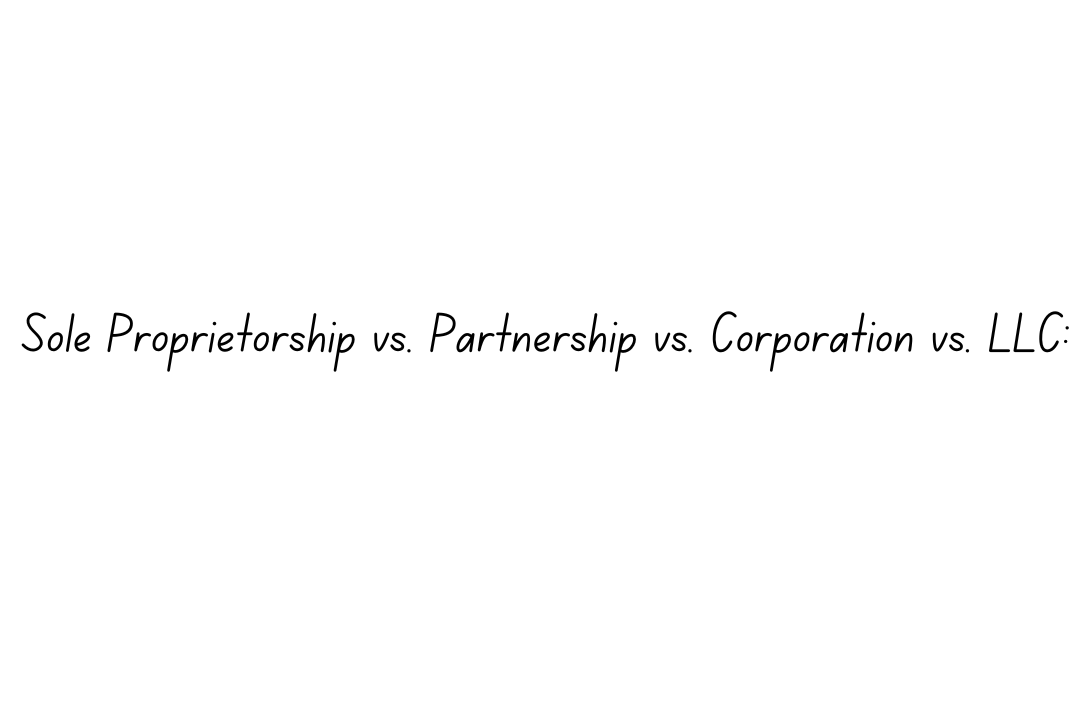
What are 5 main types of business structure with business structure examples . here are they all.
| Topic | Description |
|---|---|
| Understanding the Fundamentals of Business Structures | Overview of different business structures and their characteristics. |
| Sole Proprietorship vs. Partnership vs. Corporation vs. LLC: Pros and Cons of Each | Comparison of business structures with advantages and disadvantages of each. |
| How Your Business Structure Impacts Taxes, Liability, and Growth Potential | Analysis of how different structures affect taxation, legal liability, and potential for business expansion. |
| Registering and Formalizing Your Business Structure: Step-by-Step Guidance | Detailed steps on how to officially register and establish each type of business structure. |
| Conclusion: Choosing the Right Business Structure is Critical for Long-Term Success | Summary emphasizing the importance of selecting the appropriate business structure for sustainability. |
Discover the ideal business structure to maximize growth and profitability. Our comprehensive guide covers the key factors to consider, from legal protections to tax implications. Take the first step towards building a stronger, more successful enterprise.

Understanding the Fundamentals of Business Structures
Business structures define the organization and management of a company, influencing legal and financial responsibilities. The primary structures include sole proprietorships, partnerships, corporations, and limited liability companies (LLCs). Sole proprietorships are the simplest, with one owner responsible for all liabilities and profits. Partnerships involve two or more individuals sharing ownership, profits, and liabilities, which can be structured as general or limited partnerships. Corporations are more complex, treated as separate legal entities, offering limited liability protection to owners (shareholders), but subject to more regulations and double taxation on profits. LLCs combine the liability protection of a corporation with the tax benefits and operational flexibility of a partnership. Each structure has unique advantages and drawbacks, impacting taxes, personal liability, and administrative requirements, making it crucial for business owners to choose the one that best aligns with their operational goals and risk tolerance.

Sole Proprietorship vs. Partnership vs. Corporation vs. LLC: Pros and Cons of Each
Choosing between a sole proprietorship, partnership, corporation, and LLC depends on various factors, each with distinct pros and cons.
Sole Proprietorship: Pros:
- Simple to establish and operate.
- Complete control for the owner.
- Direct claim on profits. Cons:
- Unlimited personal liability for debts and obligations.
- Difficulty raising capital.
- Less credibility with potential clients and investors.
Partnership: Pros:
- Easy to form with shared resources.
- Combined skills and expertise.
- Direct profits and tax benefits. Cons:
- Joint liability for partners.
- Potential conflicts between partners.
- Shared profits.
Corporation: Pros:
- Limited liability protection for shareholders.
- Easier access to capital through stock issuance.
- Perpetual existence. Cons:
- Double taxation (corporate profits and shareholder dividends).
- Extensive regulatory requirements.
LLC: Pros:
- Limited liability protection.
- Pass-through taxation avoiding double taxation.
- Flexible management structure. Cons:
- More complex than sole proprietorships and partnerships.
- State-specific regulations and fees.
- Potential self-employment taxes.

How Your Business Structure Impacts Taxes, Liability, and Growth Potential
Taxes: Sole proprietorships and partnerships have pass-through taxation, meaning profits are taxed as personal income, avoiding double taxation. Corporations face double taxation—corporate profits and dividends taxed separately. LLCs typically benefit from pass-through taxation but can opt to be taxed as a corporation.
Liability: Sole proprietors and general partners face unlimited personal liability, risking personal assets for business debts. Corporations and LLCs provide limited liability protection, shielding personal assets from business liabilities, which is advantageous for risk management.
Growth Potential: Corporations have the best growth potential due to the ability to issue stock and attract investors, essential for scaling operations. LLCs offer more flexibility and protection for small to medium-sized businesses, while sole proprietorships and partnerships might struggle with capital and credibility as they expand.

Registering and Formalizing Your Business Structure: Step-by-Step Guidance
- Choose a Structure: Decide between a sole proprietorship, partnership, corporation, or LLC based on your needs.
- Select a Business Name: Ensure the name is unique and complies with state regulations.
- Register with State: File the necessary documents. For sole proprietorships and partnerships, file a DBA (Doing Business As). For corporations and LLCs, file articles of incorporation or organization with the state.
- Obtain an EIN: Apply for an Employer Identification Number (EIN) from the IRS for tax purposes.
- Apply for Licenses and Permits: Check local, state, and federal requirements and obtain any necessary licenses or permits.
- Comply with Ongoing Requirements: Maintain compliance with state filings, taxes, and annual reports to keep your business in good standing.

Conclusion: Choosing the Right Business Structure is Critical for Long-Term Success
Choosing the right business structure is critical for long-term success as it profoundly influences your company’s legal obligations, tax treatment, and growth potential. The decision impacts how much you pay in taxes, the level of risk to your personal assets, and your ability to raise capital. Sole proprietorships and partnerships offer simplicity and direct control but come with unlimited personal liability. Corporations provide strong liability protection and growth opportunities through stock issuance but face complex regulations and double taxation. LLCs balance liability protection and flexible tax options, making them a popular choice for many small to medium-sized businesses. Carefully evaluating each structure’s pros and cons in relation to your business goals, risk tolerance, and operational needs is essential. Consulting with legal and financial advisors can further ensure that you select a structure that aligns with your long-term vision, laying a solid foundation for sustainable growth and success.
“Today a reader, tomorrow a leader.” –
from caledon books
